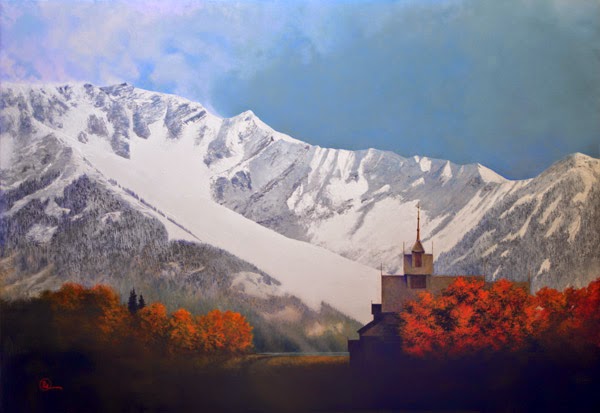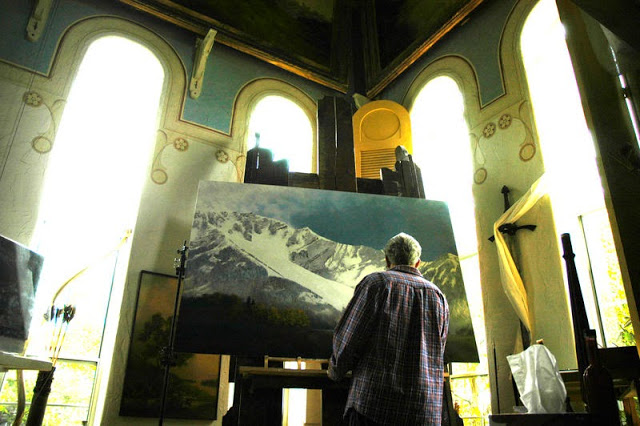Paint the mood, not the mountains
By Al R. Young
 |
| Den Kommende Vinteren by Al R. Young |
By Al R. Young
The commission to paint two scenic focal points for the Stein Eriksen Lodge Deer Valley conference center renovation included both the original oil painting and its gilded frame.
Dimensions (width x height)
69.5 in. x 48 in. (unframed)
Support
Panel
Milestones
Research begins - November 2012
Composition begins - January 2013
Brushwork begins - January 2013
Frame completed - May 2013
Equipment
Creating a painting often involves creating or modifying tools or making improvements to the studio itself.
Building a horizontal panel-support for the $10 easel
Remodeling the palette cart
Creating a piano-leg brush holder
Creating a wood-brick brush holder
Methodology
This section presents only one or two items that may be of interest to professional artists, amateurs, and others interested in the work of the Studios.
Whether painting from life, from models, from photographs, or from an image in the mind, there comes a point, in the rendering of a subject, when the focus shifts from the referent image to the image expressed in the painting (i.e., the image in the painting becomes the primary referent). At the outset of brushwork, almost all attention in the process of rendering is concerned with copying the referent subject, but as this process progresses, and the copy assumes more and more believability—more and more of its own life—elements within the copy must be reconciled with each other.
Recourse to the original referent is always, always, always necessary, but inasmuch as the copy is not the original, and inasmuch as the elements in the copy are surrounded by other elements (in the copy) that are also copies, all of those copies must be reconciled in terms of the way in which they are or have been rendered. As a painting progresses, more and more rendered elements accumulate in the painting, and the life of the copies becomes more important than the life of the referent. An artist always works from life, but not necessarily just the life of the original referent. Each painting has an existence, or life, of its own, and as that life emerges in the course of its creation, it must be taken into account.
In my experience, this shift of reference is not an absolute and complete turning away from the original referent, but something that occurs as the rendering of a feature or area of a painting becomes sufficiently developed that its expression--in order for it to be believable in the context of the painting--must be established by reconciling it with the rest of the painting.
Any artist's journey is a journey toward his or her own style of expression. Knowing what that style is or what it looks like--so as to be able to recognize it when it appears during the process of rendering--is of profound importance in dealing with this threshold. It is at or very near the threshold that the shift of focus occurs.
Ultimately, knowing when a particular part or feature of a painting is done, as well as knowing when the entire painting is finished, is a matter of painstaking reference to life and skillful articulation of what is seen there, keeping in mind that life includes the life of the referent subject, the life of the rendering, and the artist's unique style or what might be termed a way of life.
Not all that long ago, I was bent over a plein air sketch. Seated on the shore of a mountain lake, pale in the piercing sunshine of a cloudless sky, a blazing flotilla of tiny sun-boats danced upon the waves. Beyond the pool of light, mountains were nothing more than waves of land disappearing into the haze at the edge of the world. As I tried to articulate what I saw, particularly in terms of the precise contours of the distant hills, the following simple sentence came into my mind: Paint the mood, not the mountains.
 |
| Al puts finishing touches on Den Kommende Vinteren
Visit us on Pinterest to see more photos of this and other stages of the Stein Eriksen Lodge Deer Valley conference center project. |
Tags: Den Kommende Vinteren, 2013, Project commentaries, Tips and techniques
Browse articles by year: 2025 . 2024 . 2023 . 2022 . 2021 . 2020 . 2019 . 2018 . 2017 . 2016 . 2015 . 2014 . 2013 . 2012 . 2011 . 2010 . 2009 . 2008 . 2007 . 2006 . 2005 . 2004 . 2003 . 2002 . 2001 . 2000 . 1999 . 1998 . 1997 . 1996
Browse articles by topic: Art lessons . BenHaven Archives . Blank art diaries . Fine art photography . Framing . Illustration . Inspiration and creativity . Isles of Rune . Limited Editions Collection . My Fathers Captivity . News . Novellas . Oil paintings and prints . Operations announcements . Orders and shipping . Overview . Portfolios . The Papers of Seymore Wainscott . Project commentaries . Recipes by Nancy Young . Recommended reading . Recommended viewing . Temple artworks . The Storybook Home Journal . Tips and techniques . Tools supplies and operations
Browse articles by topic: Art lessons . BenHaven Archives . Blank art diaries . Fine art photography . Framing . Illustration . Inspiration and creativity . Isles of Rune . Limited Editions Collection . My Fathers Captivity . News . Novellas . Oil paintings and prints . Operations announcements . Orders and shipping . Overview . Portfolios . The Papers of Seymore Wainscott . Project commentaries . Recipes by Nancy Young . Recommended reading . Recommended viewing . Temple artworks . The Storybook Home Journal . Tips and techniques . Tools supplies and operations